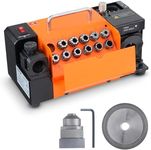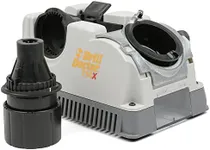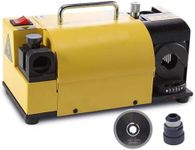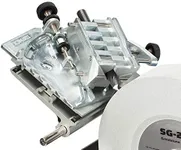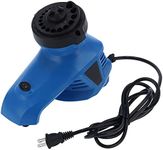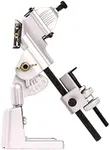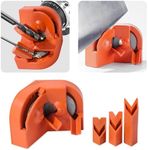Buying Guide for the Best Drill Bit Sharpeners
Choosing the right drill bit sharpener can make a big difference in the performance and lifespan of your drill bits. A good sharpener helps you maintain sharp, precise bits, which means cleaner holes, less effort, and safer operation. When shopping for a drill bit sharpener, it's important to consider how often you'll use it, the types of bits you have, and how much control you want over the sharpening process. Understanding the key features will help you pick a sharpener that matches your needs and keeps your tools in top shape.Supported Bit SizesSupported bit sizes refer to the range of drill bit diameters that the sharpener can handle. This is important because not all sharpeners can accommodate every size of bit. Some are designed for small household bits, while others can handle larger, industrial sizes. Typically, sharpeners are divided into those that handle small bits (around 1/16" to 1/2"), medium bits (up to 3/4"), and large bits (up to 1" or more). To pick the right one, consider the sizes of the bits you use most often. If you mostly work on small DIY projects, a sharpener for smaller bits will suffice. If you use a wide range of bit sizes, look for a model with broader compatibility.
Supported Bit TypesSupported bit types indicate which shapes and materials of drill bits the sharpener can handle, such as twist bits, masonry bits, or specialty bits like spade or brad-point. This matters because different bits have different angles and materials, requiring specific sharpening methods. Some sharpeners are universal, while others are limited to standard twist bits. If you use only standard bits, a basic sharpener will do. If you have a variety of bit types, look for a sharpener that can handle multiple styles to avoid needing separate tools.
Sharpening Angle AdjustabilitySharpening angle adjustability refers to whether you can change the angle at which the bit is sharpened. This is important because different drilling tasks and materials require different tip angles for optimal performance. Some sharpeners have fixed angles, which are fine for general use, while others allow you to adjust the angle for more specialized needs. If you only do basic drilling, a fixed-angle sharpener is usually enough. If you work with different materials or need precise control, choose a model with adjustable angles.
Ease of UseEase of use covers how simple and intuitive the sharpener is to operate. This includes features like clear instructions, easy bit alignment, and minimal setup. Some sharpeners are manual and require more skill, while others are electric and automate much of the process. If you're new to sharpening or want quick results, look for a user-friendly, possibly electric model. If you enjoy hands-on work and have some experience, a manual sharpener might be suitable.
Power SourceThe power source refers to whether the sharpener is manual, electric, or battery-powered. Electric sharpeners are faster and require less effort, making them ideal for frequent use or sharpening many bits at once. Manual sharpeners are more portable and can be used anywhere, but they require more physical effort and time. If you plan to sharpen bits regularly or in large batches, an electric model is convenient. For occasional use or portability, a manual sharpener may be a better fit.
Durability and Build QualityDurability and build quality describe how well the sharpener is constructed and how long it is likely to last. This is important because a well-built sharpener will provide consistent results and withstand regular use. Sharpeners made from metal or high-quality plastics tend to last longer. If you plan to use the sharpener often, look for one with solid construction and good reviews for longevity. For light, occasional use, a simpler model may be sufficient.
